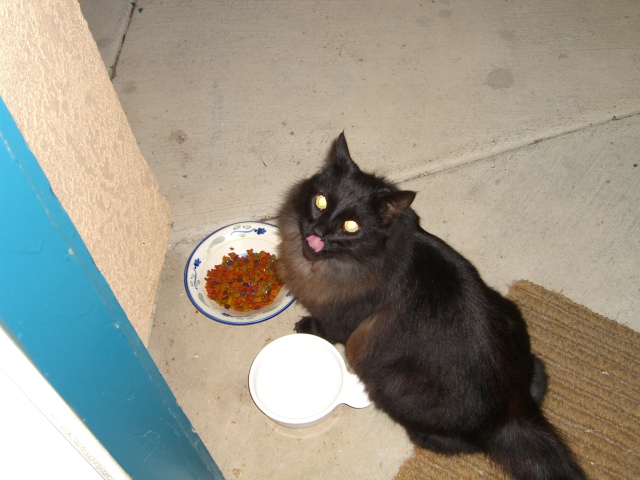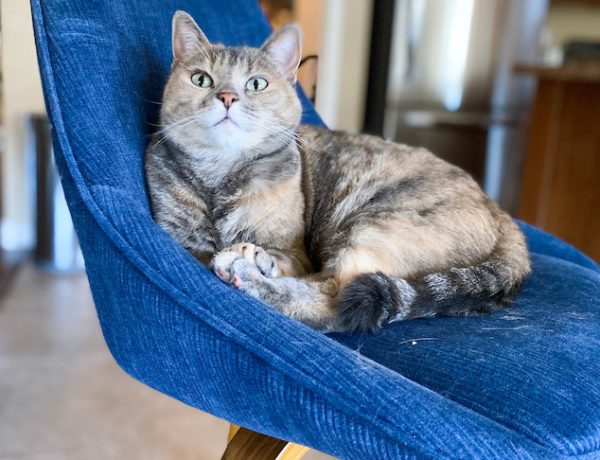How cats choose foods
Cats develop their preference for foods early in life, and studies show their mother’s food choices, genetics, and exposure to different foods all play a role in the development of cats food preferences. However, adult cats can learn new food preferences. Cats are often naturally cautious of new foods, an instinct that helps protect them from eating foods that may be toxic or poisonous. Both smell and taste are very important factors for cats. Cats are influenced by smell, flavoring, taste and texture, temperature, and their own hunger level. Red meats, fat, and liver are all highly palatable to cats. Cats can’t taste sweet, but have a preference for umami flavor, which is rich in amino acids abundant in meats. Commercial dry cat foods which are often high in carbohydrates use palatability tactics like “spray-dried plasma, yeast products, choline chloride, and hydrolysed proteins” in order to make their foods, which are lower in meats, very enticing. Cats that have only been fed dry food for long periods often develop a preference for only dry food, which means that they don’t recognize foods with other textures, moisture levels, or smells, as food.
Taking all of this into consideration, the transition process needs to be slow, and you need to be patient as your cat learns new eating behaviors and how to recognize other types of foods as food. Do not get impatient and chuck the dry food in the trash. We never starve cats into the transition. It doesn’t work, and it’s dangerous. It’s very important that during the transition process your cat is eating enough calories. There should be no unintentional weight loss during the transition. Whether it takes one week or one year, take the transition slowly, and go at your cats pace. You may take some steps forward, and some steps backwards, and that’s okay.
Start with a feeding schedule
Free roaming cats eat anywhere from 8-16 smaller prey per day to meet their nutritional requirements with meal sizes somewhere around 30-60kcal per meal. Cats natural eating behavior involves smaller meals more frequently rather than constant free access to food. Cats also have smaller stomachs than dogs, and short digestive tracts, so they really prefer to eat smaller meals more frequently rather than larger meals less frequently. Free choice feeding, or leaving a bowl of dry food out at all times for your cat, has been shown to promote obesity, and can restrict a cats natural hunger instincts, making it more challenging for them to eat new foods and variety. Establishing a feeding schedule creates a routine (which cats love), helps prevent obesity and overeating, and helps ensure your cat is hungry enough to finish their meals within 5-10 minutes. To try and transition your cat away from the nibbling behavior and onto a feeding schedule start by feeding your cat several very small meals throughout the day. Cats are incredibly smart and curious, and will pick up on a feeding routine fairly quickly with consistency. If you are feeding kibble, look at the bag of kibble to determine how many cups your cat should be eating per day, and split that into smaller meals (see the calorie section for more help on this). Ideally start with 5-8 smaller meals and start this on the weekend when you’ll be home during the day. You can also use an auto feeder to help establish this. The goal is for your cat to eat the food when it is offered, not come back and forth to nibble. If your cat doesn’t finish the meal in 10-15 minutes, remove and offer it again in 30 mins or an hour when your cat is more hungry and motivated to finish their meals. You can begin to space out meals longer and increase the amount of food per meal once your cat starts to establish meal times. The goal is to establish 3-5 meals per day. Some cats can do just fine eating 2 meals per day, however, 3 is more ideal, and older cats with a less robust digestive systems often need to eat more often than every 12hrs. How many meals you decide to feed will depend on what works in your household. If you work during the day you can also use timed auto feeders like this one from closer pets, which is also compatible with ice packs for raw food, or this one from surepet care that isn’t timed but works with a microchip so only opens for one specific cat. If you’re feeding raw you can also test out putting frozen raw food out that will thaw after several hours then be ready for your cat to eat at their meal time.
Some cats will transition to timed meals quickly, some will take longer. Take your time with this process and consider using an auto feeder to help if needed. Make sure your cat is eating enough calories during this time because again cats should not be losing weight during the transition.
Choose the right foods
Cats often have food preferences and may prefer gravies over pate, or fish over chicken. Much of this process is going to be trial and error as you try and figure out what your cat’s preference is. Try not to get discouraged at this point, just keep pivoting until you find a winner. Although my Fluff really loved fish, i found that he also really loved duck through trial and error. You’ll likely need to try several different foods and topper combinations. Additionally, fat plays a role in palatability and choosing foods with a higher fat profile, like fancy feast classic pate, feline natural, tiki after dark pouches, weruva, and nulo may be more enticing during the transition than a more lean food like tiki after dark shreds. Try different textures of foods including shreds, pate, minced, even freeze dried or fresh raw. My Fluff loved fish, so i used fishy toppers and chose some foods with some fish in them during the initial transition (I was able to wean this out over time). If you have a fish addict consider starting the transition using this process and weaning off fish after the transition to wet food is complete. I also had more success going from kibble to freeze dried raw food using this method of slowly increasing the water over time. Moisture level can be off putting to kibble addicts at first, so slowly increasing the water over time using freeze dried raw food can be a good trick to get your cat more adapted to moisture rich foods. If your cats are really craving that crunch from dry food try freeze dried raw foods like the mini nibs from Vital Essentials, or Ziwipeak air dried. I also used Ziwipeak during the transition and mixed it with kibble so i could phase the kibble out. Many cats also love meat baby food and this can also be a transition tool, just remember this is not balanced and complete food and should not be fed long term.
If your cat is a senior, be sure you’re choosing foods that are lower in dry matter phosphorus to help protect kidney function. I suggest aiming for foods that have a dry matter phos between 0.6-1.2%. If you have a cat with kidney disease 0.6-1% are the general guidelines for DM phos levels. If you aren’t sure what the DM phos is in the food, contact the company to ask or check the FAQ section under the food on Chewy’s website (they often answer this question). I also have many of them listed on in my canned food list. Tiki after dark line, weruva, and farmina all have foods that are lower in phos. If your cat has IBD or a sensitive stomach, avoid foods with heavy gums like Weruva, and consider just going to straight to a raw diet so you have better control over ingredients. Many IBD cats struggling on canned foods, even higher end canned foods, but do incredibly well on a raw or homecooked diet. If you’re feeding a kitten make sure you are choosing foods that are listed for kittens or for all life stages.
Teaching cats that wet or raw food is food
Cats that have only been fed dry food, or primarily dry food, may not recognize foods with other textures and moisture levels, as food. Before we can expect our cats to eat these foods, we have to help them establish that these new foods are food. Offering the new foods in conjunction with your cats regular food helps them associate that these foods are food. Start by offering just a small amount (a tablespoon or less) of the new food in a separate bowl or plate next to their regular food. Your cat may completely ignore it the first few days, or may just sniff it, or take a few licks. This is normal. Stay consistent and be patient. This is how you help establish that this new food is food, and this is the hardest part. To make the new food even more enticing, use your cats favorite topper or treats crushed up on top of that new food, you can even crush up their kibble and sprinkle that on top of the new food. Toppers are an incredibly important part of the transition process. Smell helps cats choose foods, and because wet and raw foods don’t have the flavor enhancers added that dry foods do, toppers are a really important part of a successfully transition. In fact, i use toppers for every single raw meal every single day. Bonito flakes are a great topper to start with, especially if your cat loves fish, as studies show cats are attracted to the umami flavor. Yeast is also a very attractive flavor to cats and is often used as a flavor enhancer in treats and kibble as it has both a meaty and cheesy like aroma. Many cats that don’t like toppers love nutritional yeast. Forti flora is another topper that can be enticing (not a very good probiotic but a lot of cats like the taste as they’re using both liver and yeast). Other toppers that work great are freeze dried meat treats, like the orijen treats (yes these are listed for ‘dogs’ but are perfectly fine for cats), and even temptations if your cat loves them (yes i hate them, but in this situation we can use them to our advantage and then wean off of them). At some point, even the most stubborn cats will get curious and start to at least nibble on the food, this may take a few days or a few weeks. Stay consistent, while also trying other food and topper combinations until you identify what your cat likes.
Slow introduction
It’s incredibly important that you introduce new foods slowly in order to avoid GI upset. Cats that have been fed only one brand of food for several years, or have only been fed dry food, have a different microbiome and will need to adjust to eating a food rotation, which means new foods must be introduced very slowly over several days. Start by offering only a tablespoon or less of the new food, either mixed in your cats current food or separately. If your cat isn’t enthusiastic about the new food, offer it in a separate bowl or plate rather than mixing it. If your cat eats the new food, wait 24hrs to be sure there is no vomiting and no diarrhea. On day 2, increase to 2 tablespoons, and again, wait 24hrs, and reduce your cats original meal calories so that you aren’t overfeeding. On average it should take 2-4 days to introduce a new food. One you’ve fully introduced the new food with no side effects, you can start your new rotation with those two foods. For example, if the old food was fancy feast classic, and the new food is Tiki cat, you can now feed fancy feast classic for breakfast, and Tiki cat for lunch, fancy feast again for dinner, and Tiki before bed. Once this rotation is established and going well, this could be after a few weeks or months, depending on your cat, add in the third food following the same protocol. Once you know your cat can eat a specific brand of food, you should be able to rotate in and out different proteins within the same line. For example if your cat eats Tiki after dark chicken and quail egg without issue, they should also be okay with the Tiki after dark beef & chicken. However, if your cat is very sensitive to food changes, or had IBD, consider making each intro slowly.
Sometimes diarrhea can happen during the transition, or because of overgrowth of certain types of bacteria in the gut, especially in young cats/kittens that have a sensitive stomach. If your cat/kitten is lethargic, refusing to eat, acting abnormally, contact your vet immediately. S. boulardii is a specific yeast based probiotic strain that helps to mitigate diarrhea, and recent cat studies show it can also help with short chain fatty acid production and maintaining a healthy diverse microbiome. You can give s. Boulardii as needed or regularly for maintenance.
If your cat is having liquid poops, you need Animal Biome S. Boulardii + FOS, Jarrow S. Boulardii, or Now S. Boulardii. My preference is the Animal Biome SB as I think it works the best. Jarrow and Now are human supplements you need to dose down for cats. To give open the capsules and mix in food or treat. Kittens under 9 months – ¼ a cap 2x a day, increase to ½ a cap 2x a day if needed. For adult cats and kittens over 9 months – ½ a cap 2x a day. Go up to 1 full cap 2x a day if needed. If you aren’t seeing good results with SB alone, try GMP from Animal biome, which has an additional phage called PreForPro that wipes other types of bacterial overgrowth.
For daily maintenance of a multi-strain probiotic, you can use Nexabiotics (which includes s. Boulardii and several other beneficial strains). Follow dosing on the capsules. If you don’t find that this helps with diarrhea, upgrade to pure s. Boulardii which has more CFUs per capsules.
How much and how often to feed
Most energy requirements are used to maintain basic metabolic functions, which is known as resting energy requirements (RER). RER is used to estimate daily energy requirements using a cat’s ideal body weight. This is a chart that can help you estimate your cats daily energy requirements. If your cat is 10lbs, his daily RER is 218kcal, and if he was prone to weight gain that would be his daily estimated calorie intake. If your 10lbs cat is 1 year old and highly energetic, his daily calories may be closer to 261kcal a day (218 x 1.2). Calories are always an estimate as each cat is an individual and calories will vary depending on age, activity level, breed, and genetics. It’s always a good idea to weigh your cat weekly to make sure he is maintaining weight, and isn’t gaining or losing weight unintentionally.
Kittens eat a lot (often twice as much as adult cats) and have very high energy requirements. Kittens are quite good at self regulation and can often be fed as much as they want. Once neutered, or close to 1 year of age, kittens will start to lower their food intake.
Each can of cat food, or bag of dry food, will say how many calories are in that product. On canned foods it will be listed on the can as kcal/can, on dry food kcal/cup. For raw or homecooked food recommendations are based on oz rather than kcal. Most adult cats will eat between 4-6oz or raw/cooked food per day (roughly estimated to be around 40-50kcal an ounce), kittens can eat up to 10oz or raw/cooked per day.
Once you know your cat’s daily estimated calorie intake you can split that into multiple meals throughout the day. If our 10lbs cats daily estimated calorie intake is 250kcal, and we want to feed 4 meals a day, each meal would be around 62kcals each. Don’t obsess over exact daily calories. Calories are always a range and you wont know what works for your cat until you start a feeding routine. If your cat seems hungry but you’re in the right calorie range, increase calories a bit. If your cat is gaining too much weight, reduce calories and check the fat content on the foods you’re feeding (lower fat can help with weight loss). Many cats are fairly good at self regulating food intake, but some cats are more food motivated than others and can be prone to overeating.
Build out a core rotation
A food rotation is just a variety of foods that you feed to your cat, and a core food rotation is a set of foods that you know your cat loves and can eat without issue. Building out this core rotation can allow you to easily switch between foods without your cat getting an upset stomach. Food rotations also help to prevent the monotony effect (boredom), cover potential nutritional gaps or excess vitamins and minerals, and ensure your cat will always have food available in the case of a recall or shortage. Additionally, increasing your cats food rotation can provide mealtime enrichment, as cats enjoy food choices, and this variety helps to build out a healthy more diverse microbiome. Food rotations also can help you save money, as rotating between higher end and more budget friendly foods can keep costs lower. Ideally you should aim for at least 3 different brands and 3 different proteins, and some variety in texture, but you can really include as many foods as your cats like. Your rotation can be canned foods only, or a combo of canned and raw or homecooked. For example, a core rotation could include Tiki after dark chicken and quail egg, fancy feast classic beef, and Wellness turkey. 3 different brands and 3 different proteins. You can build out a rotation that includes as many foods as you want.
With my own cats my core rotation includes tiki after dark chicken and quail egg, beef and chicken, feline natural chicken & lamb, lamb & salmon, lotus just juicy venison, and fresh is best freeze dried beef cat food. I don’t rotate all of these daily, but I rotation them in and out as canned food is only about 10% of my cats diet, their diet is primarily raw. Their raw rotation also includes boneless duck, beef, and rabbit with ezcomplete, and venison, pork, and elk grinds from Soul’y Raw and Viva Raw One of the major benefits of feeding a large diverse rotation is that i can buy almost any food and feed it to them without issue. I often given them fancy feast as a treat and that’s never an issue, but sometimes i will also rotate in foods like Ziwi, farmina, or Fromm without a problem and i often rotate in and out different meats for more variety.
Troubleshooting
Some cats will transition to new foods really quickly, and others will be a very slow and sometimes very frustrating process. You may take a few steps forward and a few steps backwards. If you get stuck in the transition and your cat is refusing all foods, stop the transition, give your cat the old food they’re willing to eat, and restart again once things settle down. Nausea is a common problem especially with IBD and CKD cats. If you are really struggling with the transition, or notice your cat is only going for treats, sniffing and walking away a lot, you may be dealing with nausea. Nausea symptoms can be very subtle in cats and manifest as just pickiness or finickiness. If you notice more vomiting during the transition, be sure you’re supporting the microbiome with digestive enzymes or probiotics, and that you’re feeding smaller meals more frequently to prevent acid build up. Evaluate whether or not there are gums or thickeners in the food that might be causing the vomiting, and evaluate whether or not hairballs or may be contributing the vomiting. If you notice acid vomiting in the morning (acid vomiting will look like foamy white vomit without food or green/yellow which is bile), which is more common with seniors, try feeding a fattier meal before bed, and consider leaving a small snack of freeze dried meat treats out during the night to help prevent acid build up from going 8+hrs without food. Avoid adding any unnecessary supplements to your cats new food during the transition if you have a very finicky cat, as some cats are very sensitive to supplements even probiotics and these things can put them off trying new foods.
A final reminder to be patient, be consistent, and be creative. Trial and error will help you figure out what works and what doesn’t work. If i can make the transition to a raw diet with a 13 year old cat that was addicted to fishy dry food, you can do it too.
Follow me on TikTok for more on feline nutrition and health.
Disclaimer – Feminist Kitty LLC is not a veterinarian, and this is not medical advice. Any diet, supplements, suggestions or recommendations, or anything provided on this website are for informational purposes only and should be reviewed with your veterinarian. This is not a replacement for veterinary care, medications, or diagnostics. Any diet or supplements suggestions are not intended to diagnose, treat, cure, or prevent any disease. Some links may be affiliate. As an Amazon Influencer, I earn from qualifying purchases





1 Comment
Sylvia A Valderas
June 21, 2024 at 5:24 pmWhat can I feed my cat to prevent urinary issues? I had two cats, brother and sister and Ms Elenor’s brother had a urinary blockage and we lost him, I don’t want her to go through the same and I don’t want lose her either. I’m switching her to wet food now.